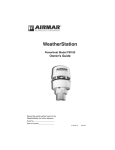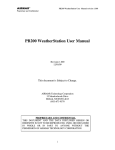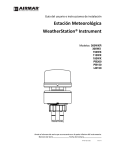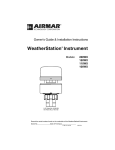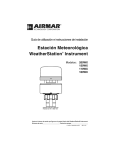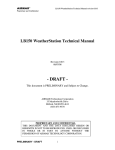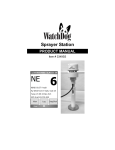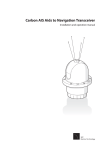Download Airmar PB200 Technical information
Transcript
WeatherStation Instrument ® Owner’s Guide Model PB200 Record the serial number found on the WeatherStation® instrument. Serial No._________________________ Date of Purchase___________________ 17-461-01 r01 01/01/08 Copyright © 2008 Airmar Technology Corp. All rights reserved. Table of Contents Introduction......................................................................................4 Safety Instructions........................................................................... 5 Adding an External Speed-Through-Water Sensor..........................6 Parts, Tools & Materials...................................................................7 Choosing the Mounting Location.................................................... 9 Installing........................................................................................ 10 Cable Routing & Connecting Guidelines...................................... 13 Connect to an NMEA 0183 Display.............................................. 14 Connect to an NMEA 2000® Network..........................................16 Calibrating the Compass................................................................ 17 Software......................................................................................... 17 Maintenance................................................................................... 17 Where to Purchase Parts................................................................ 18 Troubleshooting............................................................................. 18 Appendix A—How the WeatherStation® Instrument Works........ 20 Appendix B—Technical Information.............................................26 Acronyms & Glossary....................................................................27 3 IMPORTANT: Please read the Owner’s Guide completely before proceeding with the installation. Introduction Thank you for purchasing the Airmar ultrasonic WeatherStation instrument. This exciting product is actually six different sensors in a single unit—without any moving parts. The compact housing is waterproof with a single removable cable. Data is output in digital NMEA 0183 and NMEA 2000® formats. Functions of the WeatherStation Instrument • Apparent wind speed • Apparent wind direction • Magnetic compass heading • Air temperature • Wind chill temperature • Rate of Turn • Angle of vessel pitch • Angle of vessel roll • Barometric pressure • Global Positioning System (GPS) • Vessel speed over ground (SOG) • Vessel course over ground (COG) • True wind speed • True wind direction • Heading relative to true north • True wind chill temperature • True wind speed relative to water—requires speed-through-water input 4 WARNING Navigation Aid Only—The WeatherStation instrument is only an aid to navigation and should never be solely relied upon. It is not a replacement for traditional navigation aids and techniques. Only official government charts contain all the information needed for safe navigation. Safety Instructions WARNING: Electrical Safety The power supply voltage must be 12 VDC (±3VDC). Any other voltage may damage the product and/or result in fire, damage to the boat, and/or personal injury. WARNING: Fuse or Circuit Breaker A safe installation requires a 1 amp fast-blow fuse or circuit breaker. Failure to do so may damage the product and/or result in fire, damage to the boat, and/or personal injury. WARNING: Installation Safety Always wear safety goggles and a dust mask when installing to avoid personal injury. CAUTION: Correct Installation Important The WeatherStation instrument must be installed and operated according to the instructions in this owners guide. Failure to do so may result in poor product performance. CAUTION: Disassembly Do not disassemble the sensor. Removing the screws from the WeatherStation instrument will damage the waterproof seal, thus voiding the warranty. IMPORTANT: Compass Safe Distance The compass safe distance for standard and steering compasses is 1m (3'). Observe this distance to prevent interference to a magnetic compass. MPORTANT: Calibrating the Compass The internal compass must be calibrated. Failure to do so may result in inaccurate compass readings. IMPORTANT: Battery Make power connections to a 12 VDC power source that is isolated from the engine start battery(s). Voltage drops may cause the instrument to lose information and/or change operating mode. 5 The Importance of Understanding True Wind Direction When the WeatherStation instrument is stationary, the direction from which the wind is blowing is known as the true wind. The WeatherStation instrument is programed to measure the direction based upon the specific orientation of the sensor. For the WeatherStation instrument to accurately calculate the true direction of the wind, it must be installed and oriented correctly. (To learn more about true and apparent wind direction, see Appendix A.) Adding an External Speed-through-Water Sensor The WeatherStation instrument can receive data from an external sensor when it is connected through an optional NMEA 0183 Combiner or connected to an NMEA 2000 network. An external speed sensor processes additional received data and transmits it to the WeatherStation instrument for use in true wind calculations. In the case of NMEA 0183 protocol, simply connect the sensor to an NMEA 0183 Combiner or other NMEA 0183 repeater hardware. The data provided can be seen on displays connected to the Combiner. An NMEA 2000 speed sensor can be connected to an NMEA 2000 network. NOTE: When an external speed sensor is connected to both an NMEA 0183 device and an NMEA 2000 network, the WeatherStation instrument will use NMEA 2000 data. Speed-through-water sensor—An external speed sensor can be installed, such as an Airmar Smart™ Sensor. Airmar recommends installing the DST800V to receive water depth, boat speed, and water temperature data. 6 Parts, Tools & Materials Cables, Converting, and Connecting Hardware The WeatherStation instrument can be connected to a device and/or network in several ways. You must have the correct cable and any needed junction box before beginning the installation. Note that additional cable lengths are available. Cables NOTE: Additional cable lengths are available. • NMEA 0183 Cable • NMEA 2000® Cable • NMEA 2000® Cable 10m 6m 10m Part No. 33-862-02 Part No. 33-1029-02 Part No. 33-1029-06 Junction Boxes • • • • • NMEA 0183 to USB Converter NMEA 0183 Combiner NMEA 2000® CAN to USB Converter NMEA 0183 & NMEA 2000® Junction Box Kit NMEA 0183 & NMEA 2000® Junction Box Kit Part No. 33-801-01 Part No. 33-800-01 15m 30m Antenna Mount Antenna mount with standard marine 1" -14 threads and pass-through for cable (see Figure 1). Hardware to install antenna mount Extension tube (some installations). deck mount center pass-through deck mount side pass-through ratchet mount with extension tube extension with cable pass-through cable passes through center of mount cable passthrough Figure 1. Antenna mounts (not supplied) Copyright © 2007 Airmar Technology Corp. 7 Additional Tools and Materials Safety goggles Dust mask Pencil Level Electric drill Drill bits Deck gland (some installations) Phillips screwdrivers Plumber’s tape (optional) Grommets (some installations) Cutting pliers (some installations) Wire strippers (some installations) Electrical tape (some installations) Cable ties (some installations) Where to Purchase Parts Obtain parts from your instrument manufacturer or marine dealer. Gemeco (USA) Tel: 843.394.3565 Fax: 843.394.3736 Email: [email protected] Airmar EMEA (Europe, Middle East, Africa) Tel: 33.(0)2.23.52.06.48 Fax: 33.(0)2.23.52.06.49 Email: [email protected] 8 Min. 1m Min. 1m Figure 2. Antennas Courtesy of Northstar BNT, Acton, MA Choosing the Mounting Location For accurate readings and a reliable GPS signal, selecting the best location for the WeatherStation instrument is very important. Easy access and appearance should be secondary considerations. Since each installation is unique, the best separation distances from other equipment on the boat will vary depending on the particular equipment and how it is configured. Choose a location that balances the requirements below (see Figure 2). • The WeatherStation instrument must be mounted in “clear air”—away from obstructions in any direction that will interfere with air flowing through the unit. If there is an obstruction, be sure to mount the WeatherStation instrument at least 2m (6') away. On land, avoid roof tops, chimneys, trees, etc. • If possible, mount the WeatherStation instrument higher than any other object. Mount it a minimum of 500mm (20") above the surrounding surfaces. NOTE: The higher the WeatherStation instrument is mounted, the less accurate the pitch and roll readings will be. • Because the WeatherStation instrument has an electronic compass, it should be at least 1 m (3') away from any on-board radar equipment or other strong magnetic fields from equipment such as radio transmitters, boat engines, generators, etc. • Because the WeatherStation instrument has a GPS, it must be lower than any on-board INMARSAT communications antenna. • Because the WeatherStation instrument has a GPS, be sure it is as far as possible from high-powered transmitting antennas to avoid mutual interference. • Because the WeatherStation instrument has a GPS, check for any electromagnetic shading. That is, any obstructions from other vessels or shoreline buildings that will interfere with the GPS signals that the WeatherStation instrument must receive. 9 Installing WARNING: Always wear safety goggles and a dust mask. CAUTION: The blue metal plate and the blue film found in the wind channel of the WeatherStation instrument are essential to its operation (see Figure 3). Be careful not to scratch the plate, puncture the film, or damage them in any way. CAUTION: Do not remove the waterproof connector(s) to ease cable routing. If the cable must be cut and spliced, use Airmar’s splash-proof Junction Box No. 33-035 and follow the instructions supplied. Removing the waterproof connector(s) or cutting the cable, except when using a water-tight junction box, will void the WeatherStation instrument warranty. CAUTION: The WeatherStation instrument must be installed vertically—NOT tilted to one side. If the WeatherStation instrument is tilted from the horizontal plane, it will introduce an error in the compass reading. CAUTION: Be sure the alignment tabs on the WeatherStation instrument point forward toward the bow and parallel to the centerline of the boat. This is necessary to accurately measure wind direction and vessel heading. CAUTION: Do not tighten or align the WeatherStation instrument by rotating the upper cap (see Figure 3). Turning may sever internal connections and void the warranty. Grasp the lower housing below the blue metal plate. Hand-tighten only. upper cap waterproof film wind channel blue metal plate lower housing serial number Figure 3. Wind channel Copyright © 2008 Airmar Technology Corp. 10 WeatherStation alignment tabs face forward and parallel to the keel (centerline) of the vessel wind channel where air travels through the sensor nut assembly extension tube (most installations) cable exit (some installations) antenna mount Figure 4. Installation Copyright © 2007 Airmar Technology Corp. WARNING: Always wear safety goggles and a dust mask. 1. Place the antenna mount at the selected location and mark the holes for the screws (see Figure 1). Also, mark the hole in the center of the mount for the cable to pass through. If you are using a ratchet mount, be sure you have purchased an extension with a cable pass-through. 2. Position the antenna mount at a 90° angle to the waterline. If necessary, use shims to make the mounting surface level (see Figure 4). 3. Drill the holes for the mounting screws and the cable exit if necessary. If the cable is to be fed through the deck, install a high quality deck gland. 4. Using purchased screws, fasten the antenna mount in place. 5. Screw an extension tube onto the antenna mount if desired. 11 WeatherStation connector alignment key nut assembly captive nut Figure 5. Connecting Copyright © 2007 Airmar Technology Corp. 6. With the nut assembly on the cable near the WeatherStation connector, thread the cable through the extension tube (if used), antenna mount, and the cable exit. Be sure to leave several inches of cable extending beyond the nut assembly (see Figure 5). CAUTION: If you use a thread lock, use plumber’s tape. Do not use a liquid thread lock as it may weaken the plastic, causing it to swell and crack. 7. Screw the nut assembly onto the top of the antenna mount/extension tube. Hand-tighten only. Do not over tighten. 8. Remove the caution label from the WeatherStation instrument’s socket. Remove the protective cover from the connector. (Save the cap to protect the connector, when the WeatherStation instrument is removed.) Plug the 9-pin connector into the WeatherStation instrument. The alignment key on the connector fits into a notch in the base of the WeatherStation instrument. 9. Grasp the lower housing of the WeatherStation instrument below the blue metal plate. Being sure the alignment tabs are facing forward and parallel to the keel (centerline) of the boat, slide the captive nut upward and screw it onto the base of the WeatherStation instrument (see Figures 4 and 5). Hand-tighten only. Do not over tighten. Be careful NOT to rotate the WeatherStation instrument or loosen the nut assembly from the antenna mount/extension tube. Double check to be sure the alignment tabs are still facing forward. 12 Cable Routing & Connecting Guidelines You must read the safety instructions below before going to the section that is appropriate for your equipment. WARNING: Always wear safety goggles and a dust mask. WARNING: The power supply voltage must be 12 VDC (±3VDC). WARNING: A safe installation requires a 1 amp fast-blow fuse or circuit breaker. CAUTION: To reduce electrical interference from other electrical wiring and any on-board equipment with strong magnetic fields such as radar equipment, radio transmitters, boat engines, generators, etc., separate the cables by at least 1m (3'). CAUTION: Do not remove the waterproof connector(s) to ease cable routing. If the cable must be cut and spliced, use Airmar’s splash-proof Junction Box No. 33-035 and follow the instructions supplied. Removing the waterproof connector or cutting the cable, except when using a water-tight junction box, will void the instrument’s warranty. CAUTION: Be careful not to tear the cable jackets when passing them through bulkheads and other parts of the boat. Use grommets to prevent chaffing. CAUTION: Use a multimeter to check the polarity and the connections to the 12VDC power supply before applying power to the instrument. CAUTION: Coil any excess cable(s) and secure with cable ties to prevent damage. IMPORTANT: Make power connections to a 12 VDC power source that is isolated from the engine start battery(s). Voltage drops may cause the instrument/ receiver/sensor to lose information and/or change operating mode. 13 Connecting to an NMEA 0183 Display 1. Route the WeatherStation cable to the display. Do not fasten the cable in place at this time. 2. Connect the WeatherStation instrument to the display in one of two ways. • Connector—If your WeatherStation instrument came with a connector on the display end, and it can be plugged into the port on your NMEA 0183 display, do so now. Coil any excess cable and secure it with cable ties to prevent damage. Fasten the cable in place. • No connector—If your WeatherStation instrument does not have a connector on the display end, it must be hard wired. Refer to the owner’s manual that came with your display and connect the colored wires as shown in the table below and Figure 6. WeatherStation Function WeatherStation Cable Display Function NMEA input A/+ Yellow NMEA output A/+ (see Note 2) NMEA input B/– Orange NMEA output B/– NMEA output A/+ White NMEA input A/+ NMEA output B/– Blue NMEA input B/– 12 VDC + Red (see Note 1) 12 VDC + (see Note 3) 12 VDC –/ground Black 12 VDC –/ground Shield Bare Shield Note 1: The WeatherStation instrument must be supplied with 12 VDC (±3VDC) at 0.5 amp. Note 2: If your display does not have NMEA 0183 output connections, the yellow and orange wires are not needed and their ends should be taped separately. (Alternatively, yellow and orange wires can be connected to an external sensor.) Note 3: The display power may be wired directly to the WeatherStation cable, or it may be wired separately. No Connector—Wiring 1. Allowing an extra 25 cm (10") for wiring ease, cut the cable to length. 2. Strip 60mm (2-1/2") of the outer jacket and foil shielding from the cut end of the cable (see Figure 6). 3. Strip 10 mm (3/8") of conductor insulation from the end of each colored wire. 4. Protect the cable’s foil shielding from causing a short by using heat-shrink tubing around the jacket where the wires emerge from the cable. The tubing must overlap the wires a minimum of 6mm (1/4"). 5. Connect the wires to the display (see Figure 6). 6. Fasten all cable in place. 14 7. Your installation is complete. To begin receiving weather readings, refer to the owner’s manual that came with your display. WeatherStation connector NMEA 0183 display Figure 6. Wiring diagram to connect to an NMEA display Copyright © 2007 Airmar Technology Corp. 15 Connecting to an NMEA 2000® Network CAUTION: Only two termination resistors are required on an NMEA 2000 network. More than two will degrade the bus performance. IMPORTANT: When using a cable that is longer than 6m (20'), remove the termination resistor at the last node/tee on the NMEA 2000 network. Insert the male-to-male pin into socket 5 of the WeatherStation connector to activate the termination resistor located inside the WeatherStation instrument. Route the WeatherStation cable to the NMEA 2000 network. Plug the NMEA 2000 connector into the network node (see Figure 7). Coil any excess cable and secure with cable ties to prevent damage. WeatherStation connector NMEA 2000 network connector Figure 7. NMEA 2000 cable Copyright © 2008 Airmar Technology Corp. 16 Calibrating the Compass The internal compass must be calibrated for accurate compass readings. To calibrate the compass, use the WeatherCaster™ software and a PC. Software Installing the Software Follow the instructions in the WeatherCaster™ Software Guide. Software Updates Airmar may release updated versions of the firmware. The latest revision will be available for download through an email to you, from Airmar’s website, www.airmar.com, or a CD can be mailed by Airmar’s technical support personnel. Maintenance Since the WeatherStation instrument has no moving parts, it requires minimal maintenance. CAUTION: The blue metal plate and the blue waterproof film found in the wind channel of the WeatherStation instrument are essential to its operation (see Figure 8). The blue waterproof film protects the transducers, so be careful to keep it intact. Do not to scratch the metal plate or damage it in any way. IMPORTANT: Keep the wind channel free of SPIDER WEBS, insects, dirt, and other debris. waterproof film wind channel blue metal plate Figure 8. Wind channel Copyright © 2008 Airmar Technology Corp. 17 Where to Purchase Parts Obtain parts from your marine dealer. Gemeco (USA) Tel: 843.394.3565 Fax: 843.394.3736 Email: [email protected] Airmar EMEA (Europe, Middle East, Africa) Tel: 33.(0)2.23.52.06.48 Fax: 33.(0)2.23.52.06.49 Email: [email protected] Troubleshooting No Readings or Inaccurate Readings • • • • • Is there power to the WeatherStation instrument? Are all the connections tight? Is the cable-run free of kinks? Is the wiring correct? Are there any obstructions in the wind channel of the WeatherStation instrument? Keep it free of spider webs, insects, dirt, and other debris. Be careful not to puncture the blue waterproof film or scratch the blue plate. • Is there ice on the WeatherStation instrument? No GPS Fix • Does the WeatherStation instrument have a clear view of the sky? Wind Readings Are Too Low • Is the WeatherStation instrument mounted forward and low on the boat’s hardtop in dead air? Move the instrument farther back and higher (see Figure 9). Figure 9. Mounting location Copyright © 2007 Airmar Technology Corp. 18 NMEA 0183 Combiner Problems The LED light on the Combiner indicates its current operating mode and if an error is detected during the self-test process. See the table below. Color and Flash Count Mode and Error Condition Description of Mode and Required User Action Red No flashing Start-up mode No error Normal operation mode that should last for no more than 1.5 seconds. Any longer indicates an error with the program. No action required. Red No flashing Flash Updating mode No error The LED will stay red for the duration of the flash update operation. When the operation is complete, the Combiner will automatically reset. No action required. Amber No flashing Initialize & Self-test mode No error Normal operation mode that follows the start-up mode and should last for approximately 1 second. No action required. Green No flashing Normal & No Data mode No error Normal operation mode that follows the Initialize & Self-test mode. Indicates that no error was detected during self-test. Also, no data is currently being received by the Combiner. No action required. Green Flashing (1–10 per sec.) Normal & Data Receive mode No error Normal operation mode that indicates data is being received by the Combiner. The flash rate is proportional to the Baud rate. No action required. Amber Flashing (1 every 4 sec.) Error Trap mode EEPROM memory error An error with the EEPROM memory has been detected during the self-test mode. Reset the Combiner by powering down, waiting 60 sec., then restarting the Combiner. PC Problems If you are uncertain of the COM port on your PC, follow the steps below. 1. From the Start menu, select Control Panels. 2. Select the System option. 3. Select the Hardware tab. 4. Select Device Manager. 5. Select Ports. 6. Select Airmar NMEA 0183 – USB Converter. The Converter is powered when it is connected to the USB port on the PC. 19 Appendix A—How the WeatherStation Instrument Works About the Ultrasonic Wind Sensor The ultrasonic wind sensor (an ultrasonic anemometer) measures apparent wind speed and direction. The WeatherStation instrument contains four ultrasonic transducers, visible through the four holes in the top of the sensor’s wind channel (see Figure 10). These transducers operate in pairs—one transducer injects a pulse into the air. The pulse bounces off the metal plate at the bottom of the wind channel and is carried by the wind to arrive at the listening transducer a short time later. 4 transducers behind waterproof film wind channel metal plate Figure 10. WeatherStation ultrasonic wind sensor Copyright © 2007 Airmar Technology Corp. When there is no wind, the pulse travels at the speed of sound from the sender to the receiver. Whenever the wind is blowing in that direction, the pulse will arrive sooner than if the air is still. Similarly, whenever the wind is blowing in the opposite direction, the pulse will arrive later than if the air is still. The four transducers take turns in sending and receiving pulses. A microprocessor within the WeatherStation instrument then combines the measurements from all four transducers to calculate the resultant wind speed and direction. Throughout this process, the sensor monitors the air temperature, to compensate for the fact that the speed of sound in air changes with temperature. Understanding True and Apparent Wind The WeatherStation instrument has the unique ability to display both true and apparent wind. True wind is the actual motion of the air relative to the earth. Apparent wind is the wind which an observer experiences while moving or on board a boat. It is the result of two motions—the actual motion of the air (the true wind) and the motion of the boat. If the vessel is not moving, then the true and apparent wind will be the same. There are two components to any wind measurement: speed and direction. By convention, the wind direction is an angle representing the direction from which the wind is blowing. Sometimes this angle is referenced to true or magnetic north, and sometimes it is referenced to the bow of the vessel. Both true and apparent wind use these same references. 20 Consider the case of a vessel proceeding at a speed of 15 knots in calm air. An observer on board would experience a wind of 15 knots from dead ahead. This apparent wind would be due solely to the motion of the boat. If a true wind of 15 knots was blowing from the stern, an observer would experience dead calm—no apparent wind. That is because the boat is moving at the same speed and in the same direction as the surrounding air. Now, consider the more complicated situation of a vessel proceeding at 15 knots with a true wind of 15 knots blowing from the side (see Figure 11). To an observer on board, the apparent wind would be 21.2 knots blowing from an angle 45º off the bow. 15 knots COG 21.2 knots apparent wind 15 knots true wind Figure 11. Apparent wind Copyright © 2007 Airmar Technology Corp. In order to calculate the true wind speed and direction when on board a moving vessel, it is necessary to know the apparent wind speed and direction, the speed and course over ground of the vessel, the compass heading, and the local magnetic variation. Note that heading and course are not the same thing: heading is the direction the bow of the vessel is pointing, while course is the direction the vessel is traveling. Heading and course may differ due to the effects of wind and current. The WeatherStation instrument can provide true wind speed and direction only if all of the data is available. The speed and course over ground must be provided by a GPS receiver––either built-in or networked. The heading may be provided by either the built-in electronic compass or by an external networked compass. Because true wind is calculated using the data from several sensors, its accuracy depends on the accuracy of all the raw data used in the calculation. For instance, if the electronic compass is located near iron or a similar magnetic disturbance, the heading will be incorrect, and the true wind calculation will therefore be in error, perhaps by quite a bit. In another example, the speed and course over ground provided by the GPS receiver are averaged over time. If the boat is performing maneuvers, changing speed and/or direction, then it will take a few seconds for the SOG and COG values to "catch up". The reported true wind values will therefore also be incorrect until the vessel reaches a steady-state condition, traveling in a straight line at a constant speed. 21 About the Electronic Compass The WeatherStation instrument includes three magnetoinductive sensors that measure magnetic field-strength in three axes relative to the instrument. From combined measurements of the three-axis magnetic and tilt sensors, it calculates the resultant magnetic heading angle, thereby providing a built-in three-axis electronic compass. Like all magnetic compasses, the WeatherStation compass will be affected by any ferrous or magnetic materials in the vicinity, such as metal structures, motors, speakers, etc. It will also be affected by nearby electric fields, such as the wiring for navigation lights or radar domes. These nearby sources of magnetic interference will distort the magnetic field and produce errors in the compass heading. These errors are known as magnetic deviation. About Magnetic Variation and True Heading The earth acts like a giant magnet, with a magnetic north pole and a magnetic south pole. The axis of the magnetic poles is offset approximately 11.5° from the axis of the earth's rotation. Therefore, the earth's magnetic north and south poles are in different locations than the earth's geographic north and south poles. In addition, the earth's magnetic field is non-uniform, and changes over time. Magnetic variation, also known as magnetic declination, is the angle between magnetic north and true (or geographic) north, at the observer's current location. A magnetic compass measures heading with respect to magnetic north. To convert this magnetic heading to true heading (that is, heading with respect to true north), the magnetic variation must be added to the measured magnetic heading value. Because magnetic variation changes with location and gradually over time, it is necessary to calculate the magnetic variation using the user's present position and the current date. Therefore it is necessary to have a GPS with a fix in order to provide magnetic variation and heading with respect to true north. About the Air Temperature Sensor The WeatherStation instrument includes a built-in negative-temperaturecoefficient thermistor that measures the ambient air temperature. This NTC thermistor is located in a thermally isolated region of the WeatherStation housing that is open to the outside air. About Wind Chill Temperature Wind Chill is a term that describes the heat loss on the human body resulting from the combined effects of low temperature and wind. As wind speed increases, heat is carried away from the body at a faster rate, causing a reduction in skin temperature. Because the face is the part of the human body that is most likely to be exposed, the wind-chill index is adjusted for the average adult face. The concept of wind chill does not apply to inanimate objects, such as a boat. The only effect that wind chill has in this case is to shorten the time it takes the object to cool to the actual air temperature––wind chill does not cause an object to cool below that temperature. For example, fresh water freezes at 0°C (32°F) regardless of what the wind chill is. 22 The WeatherStation instrument calculates two values for wind-chill temperature: one using the apparent wind-speed, and one using the true wind-speed. The apparent wind-chill temperature is relevant to what an observer is currently experiencing on the vessel. The true wind-chill temperature indicates what the wind chill would be if the vessel were not moving. Wind chill temperature is only defined for temperatures at or below 10°C (50°F) and wind speeds above 2.6 knots (3MPH). By default, transmission of wind-chill data is disabled by the WeatherStation instrument. When used with WeatherCaster software, the wind-chill data will be automatically enabled. About the Barometric Pressure Sensor The WeatherStation instrument contains a temperature-compensated, silicon, piezoresistive, pressure sensor. It measures atmospheric pressure for use as a digital barometer. While a single measurement of air pressure at a given location has little value, the trend of changing pressure and wind over time can be a useful tool in performing basic weather forecasting. About the GPS Some WeatherStation instruments have a built-in Global Positioning System with their own antenna, receiver, and position determining electronics. The GPS receiver receives radio signals from a constellation of orbiting satellites maintained by the U.S. government. By accurately measuring the time it takes for a transmission to travel from each satellite to the receiver, the unit is able to determine the distance between the satellite and the receiver. When the distance is known to three satellites, the unit is able to calculate the latitude and longitude of the receiver. This is known as a 2D fix. If the distance is known to four or more satellites, then the unit is additionally able to calculate the altitude of the receiver. This is known as a 3D fix. The GPS receiver in the WeatherStation instrument takes approximately one minute on average to achieve a position fix after power is first applied. This is known as the "time to first fix." The GPS receiver synchronizes itself to the atomic clocks on board each satellite. This allows the GPS receiver to accurately determine the date and time as well. If the GPS receiver is mounted on a moving vessel, its changing position over time allows the speed and course over ground to be calculated. The course reported by a GPS is always with respect to true north. The ability of the WeatherStation instrument to calculate true wind speed and direction depends on the presence of a GPS fix. If the GPS receiver is not tracking at least three satellites, then the WeatherStation instrument will be unable to provide true wind data. (Apparent wind data should always be available, regardless of the status of the GPS receiver.) Certain models of the WeatherStation instrument do not include a built-in GPS receiver. In this case, if the true wind capabilities of the WeatherStation instrument are desired, it will be necessary to connect the output from an external NMEA 0183-capable GPS to the NMEA input on the WeatherStation instrument (or to the 23 optional Combiner), in order to enable the true wind capabilities of the WeatherStation instrument. Even if your WeatherStation instrument includes a built-in GPS receiver, you may wish to use a separate external GPS receiver instead, for the determination of true wind. If the WeatherStation instrument receives speed over ground and course over ground (SOG and COG) data on its NMEA input from an external GPS, these data will override the data from the built-in GPS for the purpose of calculating true wind speed and direction. In addition, the WeatherStation instrument will automatically suppress transmission of GPS messages from its own built-in GPS receiver. About True Wind Relative to Water If a fix from a GPS receiver is not available, it is still possible for the WeatherStation instrument to determine a value for true wind, if the speed of the vessel through the water is known. In this case, it is necessary that a water-speed sensor with an NMEA output (such as an Airmar Smart™ Sensor) be connected to the NMEA input on the WeatherStation instrument (or to the optional Combiner). The WeatherStation instrument's calculation for true wind relative to water makes the significant simplifying assumption that the vessel's course is the same as its heading. That is, the effects of wind and current on the motion of the boat are ignored. The direction of the true wind relative to water is referenced only to the bow of the vessel, not to true or magnetic north. 24 Appendix B—Technical Information NMEA 0183 Sentence Commands * These sentences are enabled at the factory. $GPDTM $GPGGA * $GPGLL $GPGSA $GPGSV $HCHDG $HCHDT $WIMDA * $WIMWD $WIMWV * $WIMWV $GPRMC $TIROT * $GPVTG * $WIVWR $WIVWT $YXXDR $GPZDA * $PFEC, GPatt * $PFEC, pidat Datum Reference GPS Fix Data Geographic Position –Latitude/Longitude GNSS DOP and Active Satellites GNSS Satellites in View Heading, Deviation and Variation Heading True Meteorological Composite. Barometric Pressure, Air Temperature, Wind Direction, Wind Speed Wind Direction and Speed, with respect to north Wind Speed and Angle, in relation to the vessel’s bow /centerline (relative) Wind Speed and Angle, in relation to the vessel’s bow /centerline (theoretical) Recommended Minimum Specific GNSS Data Rate of Turn Course Over Ground and Ground Speed Relative Wind Speed and Angle True Wind Speed and Angle Transducer Measurements: Wind Chill and Vessel Attitude Time and Date Heading, Pitch, and Roll Additional Data Available from the WeatherStation Instrument There are parameters that the WeatherStation instrument can make available to the user. Usually, more data is available from the WeatherStation instrument than can be displayed in a reasonable format on a screen. Also, if all the data was continuously transmitted to the display, the update rate would be too slow and could not keep up with WeatherStation measurements. Consequently, some parameters are transmitted while others are not, based on a pre-selected list—the NMEA 0183 sentences with an asterisk. Note that those parameters not transmitted are, nevertheless, retained in the WeatherStation instrument. For more detailed information, see the “Technical Manual” on the WeatherStation CD. NMEA 2000® PGN Commands Transmitted NMEA 2000® PGNs PGN 059392 PGN 060928 PGN 065285 PGN 065287 PGN 126208 PGN 126464 PGN 126720 PGN 126720-32 ISO Acknowledgment ISO Address Claim Proprietary: Boot State Acknowledgment Proprietary: Access Level Acknowledge Group Function PGN List - Transmit/Received PGN's Group Addressable Multi-Frame Proprietary Proprietary: Attitude Offsets 25 PGN 126720-33 PGN 126720-34 PGN 126720-35 PGN 126720-49 PGN 126720-50 PGN 126992 PGN 126996 PGN 126998 PGN 127250 PGN 127251 PGN 127257 PGN 127258 PGN 129025 PGN 129026 PGN 129029 PGN 129033 PGN 129044 PGN 129538 PGN 129539 PGN 129540 PGN 130306 PGN 130310 PGN 130311 PGN 130323 PNG 130822 PNG 130823 PGN 130880 PGN 130881 PGN 130944 PGN 65281 Proprietary: Calibrate Compass Proprietary: True Wind Options Proprietary: Simulate Mode Set WAAS Satellite Set Tzz Parameter System Time Product Information Configuration Information Vessel Heading Rate of Turn Attitude Magnetic Variation Position, Rapid Update COG & SOG, Rapid Update GNSS Position Data Time & Date Datum GNSS Control Status GNSS DOPs GNSS Sats in View Wind Data Environmental Parameters Environmental Parameters Meteorological Station Data Unit Division Code (FEC) Browser Control Status (FEC) Proprietary: Additional Weather Data Proprietary: Heater Control Proprietary: POST Terminator Status (FEC) Received NMEA 2000® PGNs PGN 059904 PGN 060928 PGN 065286 PGN 126208 PGN 126208 PGN 126720 PGN 126720-1 PGN 126720-130 PGN 126720-132 PGN 128259 PGN 126208 PGN 130821 ISO Request ISO Address Claim Proprietary: Boot State Request Request Group Function Command Group Function Addressable Multi-Frame Proprietary Proprietary: Master Reset Proprietary: Reset EEPROM Proprietary: Reset GPS Speed WAAS ON/OFF NavSource Speed (FEC) Additional Data Available from the WeatherStation Instrument There are parameters that the WeatherStation instrument can make available to the user. Usually, more data is available from the WeatherStation instrument than can be displayed in a reasonable format on a screen. Consequently, some parameters are transmitted while others are not. Note that those parameters not 26 transmitted are, nevertheless, retained in the WeatherStation instrument. For more detailed information, see the “Technical Manual” on the WeatherStation CD. Baud Rate WeatherCaster™ software needs the baud rate to be set as follows: NMEA 0183 USB Converter baud rate 4800. NMEA 0183 Combiner baud rate 38400. Load Equivalency Number LEN......................... 13 Calibration The WeatherStation instrument is calibrated at the factory and does not require any calibration after purchase. Acronyms CD COG COM Port DOP GNSS GPS LED LEN PC SOG UNS USB WAAS 2D 3D Compact Disk Course Over Ground Communications Port Dilution Of Precision Global Navigation Satellite System Global Positioning System Light Emitting Diode Load Equivalency Number Personal Computer Speed Over Ground Unified National Standard Universal Serial Bus Wide Area Augmentation System Two Dimensional GPS Fix Three dimensional GPS Fix Glossary Firmware WeatherCaster™ software The software within the WeatherStation hardware The PC application program Trademarks Airmar® is a registered trademark of Airmar Technology Corporation. NMEA 2000® is a registered trademark of the National Marine Electronics Assoc. Smart™ Sensor is a trademark of Airmar Technology Corporation. WeatherCaster™ is a trademark of Airmar Technology Corporation. WeatherStation® is a trademark of Airmar Technology Corporation. 27 35 Meadowbrook Drive, Milford, New Hampshire 03055-4613, USA www.airmar.com 28






























